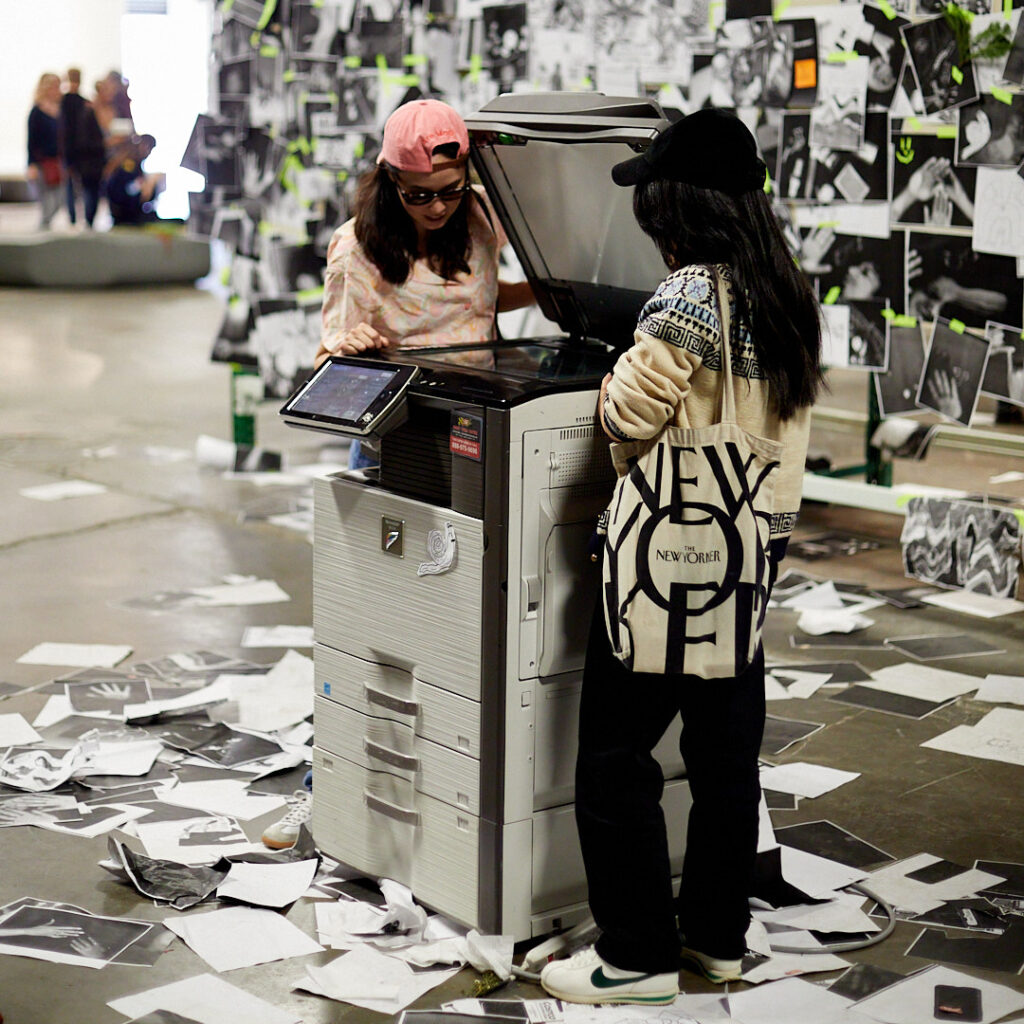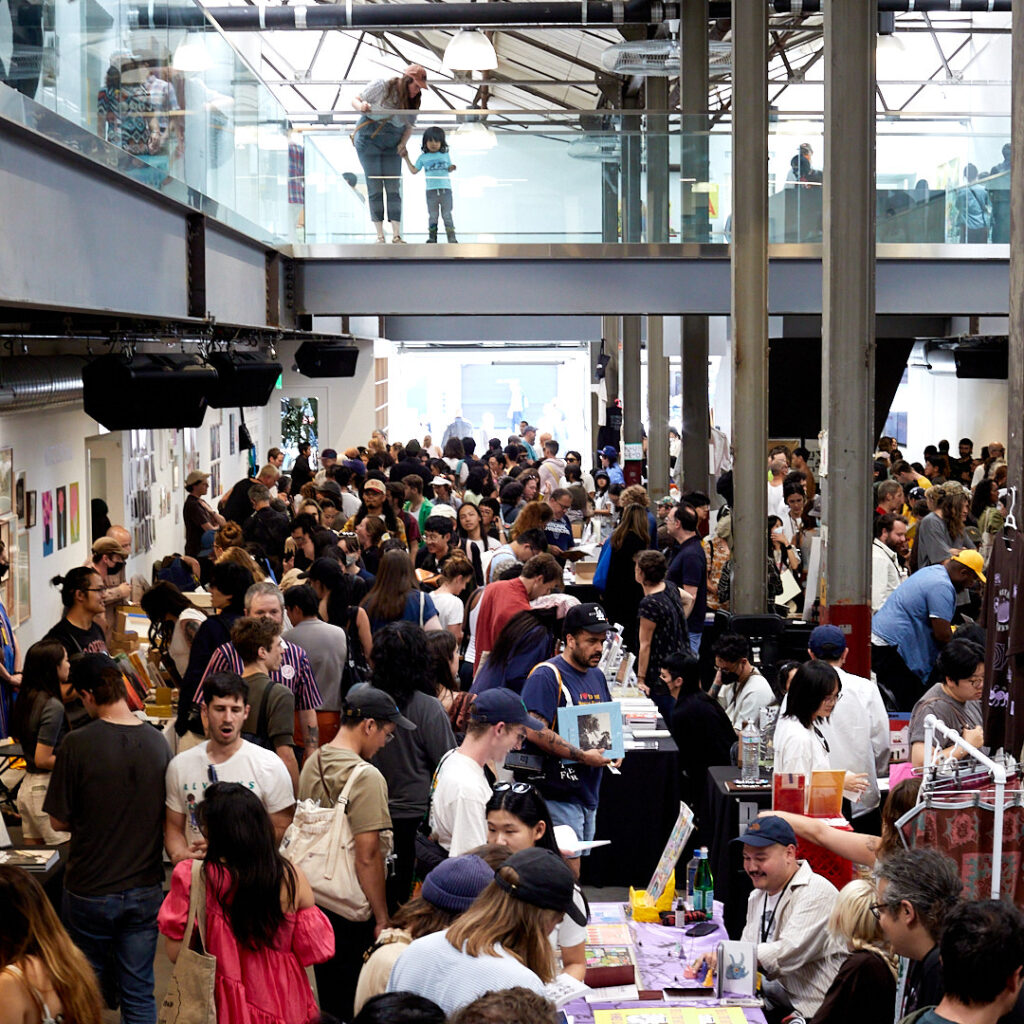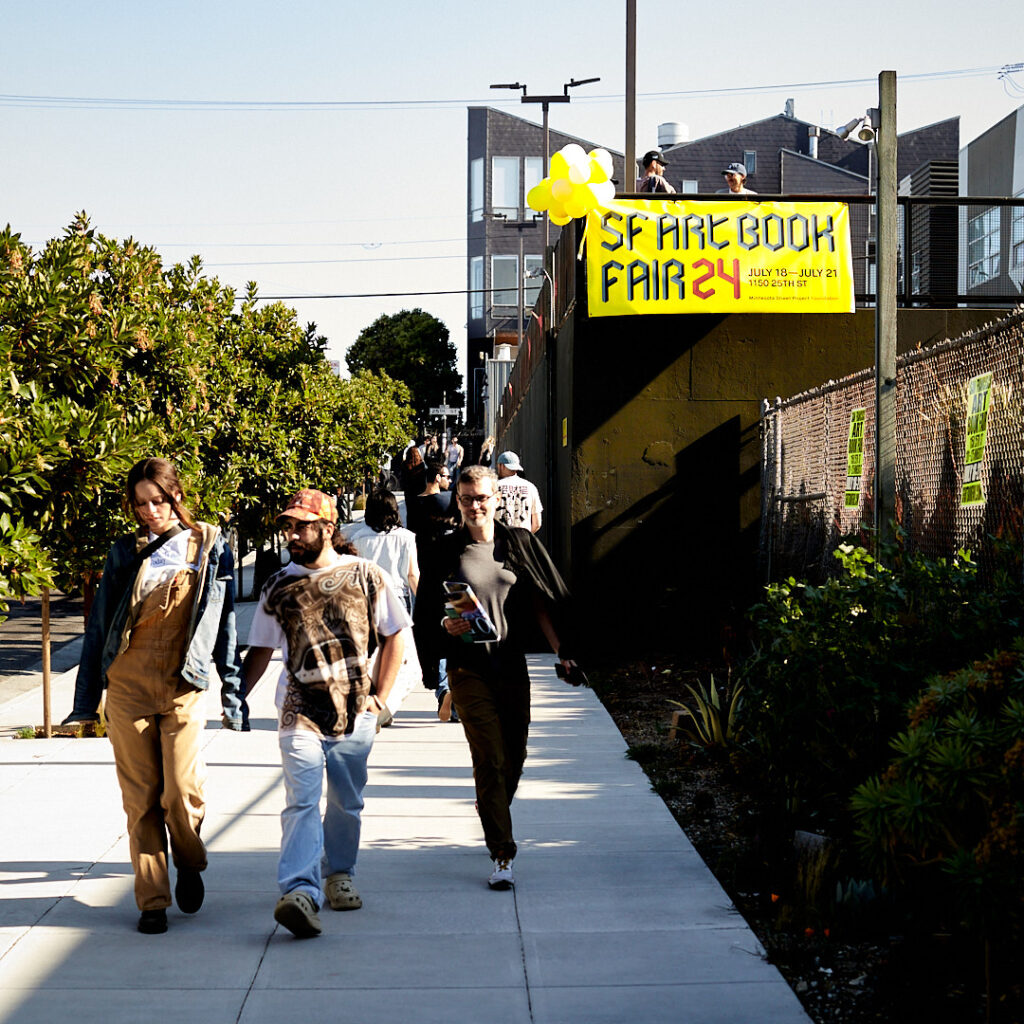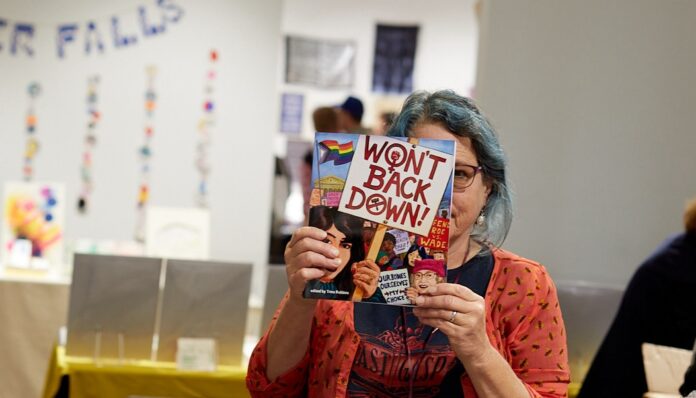Artist Leah Rosenberg stood in a former popcorn factory, arranging flowers, talking about one of the activities that made this year’s San Francisco Art Book Fair, which ran July 18-21 at Dogpatch neighborhood artistic nexus Minnesota Street Project, so special.
“Bouquets usually have bunch of color and people can color it back in maybe and that’s more participatory,” she told 48hills. “They can make their own bouquet and then take a photo of it, in a way, with the Xerox machine.”
Rosenberg was hosting a Xerox Party on the opening night of the fair. For it, she had brought flowers, many grown in her plot at the Potrero del Sol Community Garden, supplemented with ferns from the market. People were Xeroxing black-and-white copies of the flowers—or whatever they had on hand, including loose change, their phones, keys, and easily available body parts—on the several massive copy machines provided. Their copies were then displayed to the book fair hordes. While Rosenberg was talking, a little girl (with her parents’ help to reach the machine) enthusiastically made a copy of a handful of ferns.

This was the fair’s seventh edition, which featured 150 vendors, many of them local, like Oakland’s PM Press, Sming Sming Books in Saratoga, and San Francisco’s Last Gasp. In addition to gleefully using the Xerox machines, 27,000 attendees bought monographs and books, attended talks and signings, and took in performances.
The event’s co-founders, Luca Antonucci of Colpa Press and Park Life‘s Jamie Alexander, started thinking about putting together a local book fair about 10 years ago, after attending Printed Matter, Inc.‘s events. They had been impressed by the attention that non-profit showed to exhibitors and its commitment to keeping participation in fairs financially feasible for vendors and presenters through low table fees and honorariums. Antonucci saw an opportunity for showcasing San Francisco’s rich publishing history.
“We have Funk art and all these things that are unique to the Bay Area, and when it crosses over with publishing it feels radicalized, which has always kept me here,” he said. “There’s this extra effort to tell the story of subcultures here in the Bay Area. With everything progressing so rapidly in tech, I just feel like it’s extra important to make that effort to tell the story of the people that were here and the people that are still here.”
When the duo launched their book fair in 2016, there were hardly any like it in town, Alexander says. Now there are a multitude of similar events. But he says that SF Art Book Fair continues to improve, and that its production, staffing, and beautiful location at MSP make it stand out.
“Most of the time, venues are treated like event spaces. You rent them out and you produce everything, and then everyone just wipes their hands at the end of the day,” Antonucci said. “Our idea was, why don’t we build this as an entity, and we all have equal stakes in it?”

Rachel Sample, executive director of the Minnesota Street Project Foundation, says leadership at her organization is equally delighted with the partnership. MSP opened in 2016 in three former warehouses. Two became gallery spaces, and another now hosts the group’s studio program. When the neighboring Thatcher Gourmet Popcorn Factory pulled up stakes, the MSP Foundation acquired its massive space and turned it into a video screening gallery. Trevor Paglen‘s single-channel video Doty will show there from September 19 through October 5, shown in conjunction with CARDINALS, Paglen’s solo exhibition at MSP’s Altman Siegel.
Along with the galleries, MSP is home to Art Services, which installs, deinstalls, stores, and ships art. Then there’s its non-profit foundation, established in 2019, which Sample says, “looks for ways to help the artistic tapestry of San Francisco thrive.”
The foundation runs the site’s 40-plus artist studios. Considering local need for stable, affordable studios, the program is due for an expansion, Sample says.
Photo and video artist Trina Robinson considers herself lucky to have a studio at MSP. Having worked in high pressure industries like magazine publishing and tech, Robinson likes being around its different kind of energy.
“Everyone here works so hard at such a high level,” she said. “It’s very inspiring.”
Robinson is on the board of residency housed in the artist studios, Black (Space) Residency, co-founded by Erica Deeman and Ashara Ekundayo. Robinson took its teenage interns (via a program in partnership with the Museum of the African Diaspora) to Rosenberg’s Xerox party. Although most of the young people didn’t know what a Xerox was, Robinson says they enjoyed using the copier and getting a behind-the-scenes look at the book fair.
Robinson even had some her own work showing at the fair, which she called an incredible experience. Courtney Sennish, who prints Robinson’s copper plate photogravures, Memory Index: Imagined Family Heirlooms, recently formed Moonlight Press with fellow master printer Nichol Markowitz. They showed photos of Robinson’s prints on paper she made from palm fronds from Cameroon and cotton from a Black-owned farm.
In the same way Robinson appreciates the camaraderie of working with other artists, Candace Huey of re.riddle, on the second floor of MSP, likes being around other gallery owners. Huey, who is hosting the show summer snow: joey leung and lawman, through the end of August, has been with MSP since last fall. Before, the gallery was a pop-up, but she says after COVID, she wanted a home—and she appreciates the collegial spirit at MSP.
“It’s truly genuine. Everyone’s really kind and supportive,” Huey said. “It’s nice to feel part of a village, supporting one another.”

Katherine Hamilton, communications associate at Hashimoto Contemporary Art—whose founder Ken Harman Hashimoto also owns Paragon Books, a fair vendor—likes the diversity of the galleries at MSP.
“It’s nice to walk across the atrium and see another show of different artists” she said. “It’s galleries at different stages in their careers, and it feels eclectic, right? We’ve just celebrated our 10-year anniversary, and we’re starting to feel a little bit older. Then you walk across to Anglim/Trimble, or upstairs to Jack Fisher, and they’ve been in San Francisco for so much longer. Or then, Candace’s gallery re.riddle, is very new, and showing some really interesting programs.”
“It’s really nice to be able to engage people in a way where you hope that they’ll return,” Hamilton continued. “We let them know about other projects that we do. ‘Oh, you like this artist? Well, actually, we show a lot of their paintings, so you’d probably want to come back.’”
And people do keep coming back, Alexander says.
“It’s accessible and grassroots, not like an art fair, where it’s exclusive and prohibitive,” he said. “It’s totally inclusive and it’s a place where commerce is able to happen, where people that create on a small level from zines all the way up to art books and prints are able to bring their wares to the public. And 10 years ago, there weren’t a lot of venues for that.”
Learn more about San Francisco Art Book Fair here.




